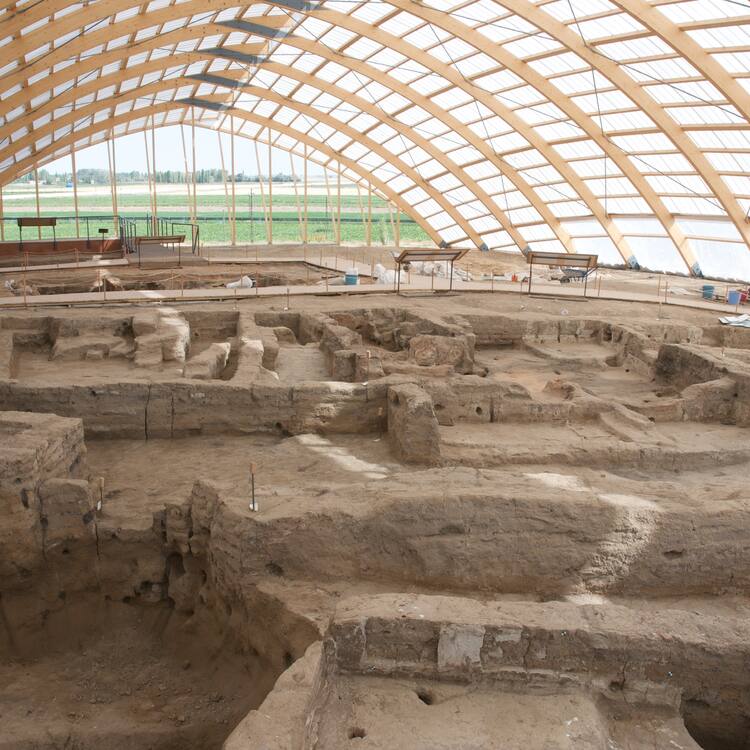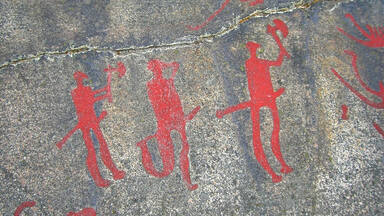Neolithic Site of Çatalhöyük
Neolithic Site of Çatalhöyük
Two hills form the 37 ha site on the Southern Anatolian Plateau. The taller eastern mound contains eighteen levels of Neolithic occupation between 7400 bc and 6200 bc, including wall paintings, reliefs, sculptures and other symbolic and artistic features. Together they testify to the evolution of social organization and cultural practices as humans adapted to a sedentary life. The western mound shows the evolution of cultural practices in the Chalcolithic period, from 6200 bc to 5200 bc. Çatalhöyük provides important evidence of the transition from settled villages to urban agglomeration, which was maintained in the same location for over 2,000 years. It features a unique streetless settlement of houses clustered back to back with roof access into the buildings.
Description is available under license CC-BY-SA IGO 3.0
Site néolithique de Çatal Höyük
Les deux grands tertres de Çatal Höyük forment ce bien de 37 hectares situé dans le sud du plateau anatolien. Le tertre oriental, qui est le plus haut, présente 18 niveaux d’occupation néolithique datant de 7400 à 6200 av. J.-C. Il rassemble des peintures murales, des bas-reliefs, des sculptures et d’autres éléments artistiques et symboliques. Les deux tertres témoignent de l’évolution de l’organisation sociale et des pratiques culturelles au moment où les êtres humains s’adaptaient à la vie sédentaire. Le tertre occidental témoigne de l’évolution des pratiques culturelles pendant la période chalcolithique datant de 6200 à 5200 avant J.-C. Çatal Höyük fournit un important témoignage de la transition qui s’est opérée entre les villages et les agglomérations urbaines qui se sont succédé sur un même lieu pendant plus de 2000 ans. Il s’agit d’un site présentant une organisation unique composée de maisons serrées les unes contre les autres, sans rue, et avec accès par les toits.
Description is available under license CC-BY-SA IGO 3.0
Sitio neolítico de Çatalhöyük
Dos colinas forman este sitio del sur de la llanura de Anatolia, cuya superficie supera los 137.000 metros cuadrados. El mónticulo de mayor altura, situado al este, contiene huellas de 18 niveles de ocupación neolítica entre los años 7.400 y 6.200 a. de C., que incluyen pinturas murales, relieves, esculturas y otros rasgos simbólicos y artísticos. Juntos, atestiguan la evolución de la organización social y las prácticas culturales a medida que los humanos se adaptaron a la vida sedentaria. La colina occidental muestra la evolución de las prácticas culturales del Calcolítico (6.200 a 5.200 a. de C.). Çatalhöyük contiene vestigios importantes de la transición de pueblos a aglomeraciones urbanas que se mantuvieron en el mismo emplazamiento durante más de 2.000 años. Se trata de un conjunto único de casas agrupadas sin calles.
source: UNESCO/CPE
Description is available under license CC-BY-SA IGO 3.0
チャタルホユックの新石器時代遺跡群
南アナトリアのコンヤ平原に、東西に並ぶ2つの遺丘。東丘には紀元前7400年頃から同6200年頃までの、18層にわたる新石器文化の堆積があり、アナトリア最初期の定住農耕村落の発達過程を示す稀有な遺跡。密集した住居群の間に街路はなく、家屋は屋根から出入りする形式で、新石器時代の住居形式の典型例である。村落が数世紀にわたって、平等主義に基づいて発展してきたことを伝えるこの遺構は、保存状態が良好で、2ヵ所に大屋根をかけることによって出土時の状態が保たれている。source: NFUAJ
Neolithisch gebied van Catalhöyük
Het archeologische gebied van Çatalhöyük bestaat uit twee heuvels die 20 meter uitsteken boven de Konya-vlakte op het zuidelijke Anatolische Plateau. De grotere oostelijke heuvel bevat achttien niveaus van neolithische bewoning tussen 7400 en 6200 voor Christus, waaronder muurschilderingen, reliëfs, sculpturen en andere symbolische en artistieke uitingen. De westelijke heuvel toont de culturele ontwikkeling tijdens de chalcolithische periode van 6200 tot 5200 voor Christus. Catalhöyük toont de overgang aan van dorpen naar een stedelijke agglomeratie, die daar meer dan 2000 jaar gehandhaafd bleef. Het gebied wordt gekenmerkt door een unieke straatloze reeks woningen, geclusterd met hun achterkanten tegen elkaar en toegang via het dak.
Source: unesco.nl
Outstanding Universal Value
Brief synthesis
The vast archaeological site of Çatalhöyük comprises two tells rising up to 20 meters above the Konya plain on the Southern Anatolian Plateau. Excavations of the Eastern tell have revealed 18 levels of Neolithic occupation dating from 7,400-6,200 BC that have provided unique evidence of the evolution of prehistoric social organisation and cultural practices, illuminating the early adaptation of humans to sedentary life and agriculture. The Western tell excavations primarily revealed Chalcolithic occupation levels from 6,200-5,200 BC, which reflect the continuation of the cultural practices evident in the earlier Eastern mound.
Çatalhöyük is a very rare example of a well-preserved Neolithic settlement and has been considered one of the key sites for understanding human Prehistory for some decades. The site is exceptional for its substantial size and great longevity of the settlement, its distinctive layout of back-to-back houses with roof access, the presence of a large assemblage of features including wall paintings and reliefs representing the symbolic world of the inhabitants. On the basis of the extensively documented research at the site, the above features make it the most significant human settlement documenting early settled agricultural life of a Neolithic community.
Criterion (iii): Çatalhöyük provides a unique testimony to a moment of the Neolithic, in which the first agrarian settlements were established in central Anatolia and developed over centuries from villages to urban centres, largely based on egalitarian principles. The early principles of these settlements have been well preserved through the abandonment of the site for several millennia. These principles can be read in the urban plan, architectural structures, wall paintings and burial evidence. The stratigraphy of up to 18 settlement layers provides an exceptional testimony to the gradual development, re-shaping and expansion of the settlement.
Criterion (iv): The house clusters of Çatalhöyük, characterized by their streetless neighbourhoods, dwellings with roof access, and house types representing a highly circumscribed distribution of activity areas and features according to a clear spatial order aligned on cardinal directions, form an outstanding settlement type of the Neolithic period. The comparable sizes of the dwellings throughout the city illustrate an early type of urban layout based on community and egalitarian ideals.
Integrity
The excavated remains of the prehistoric settlement spanning 2,000 years are preserved in situ in good condition, and are completely included in the property boundaries. The two archaeological mounds rise from the surrounding plain and constitute a distinctive landscape feature which has preserved its visual integrity. Shelters constructed above the two main excavation areas protect the archaeological structures from direct effects of the climate and thereby reduce the immediate dangers of rainfall and erosion.
Authenticity
The archaeological remains of Çatalhöyük have retained authenticity in material, substance, location and setting.Over forty years of well-documented research and excavation at the site bear testimony to the site’s readability as an early Neolithic settlement and thereby its authenticity. The site and excavations are well preserved. The physical mass and scale of the mounds have not much altered since the site was first discovered in 1958.
Protection and management requirements
The property is protected at the highest level as an ancient monument under the Turkish Directorate General of Monuments by Law 2863/1983 on the Protection of Cultural and Natural Heritage amended in 1987 and 2004. It was registered as a conservation site on the national inventory of 1981 by the Superior Council for Immovable Antiquities and Monuments. According to these instruments, local authorities are also responsible for the property’s protection.
The management of the site is supervised by the Çatalhöyük Coordination and Supervision Council (CSC), an Advisory Board and a Management Plan team. A site manager has been formally appointed and a Management Plan team including experts from the excavation team in Çatalhöyük and the departments related to the Ministry of Culture and Tourism has also been established. On the basis of the experience gained with a previous management plan drafted in 2004, the new management plan to be adopted shall contain specific sections on visitor management, access, education, risk preparedness and involvement of the local community and is announced to be finalized in late 2012.The provision of regular financial and human resources, as well as a dedicated archive for documentation of excavation and conservation activities are key to the management system.



